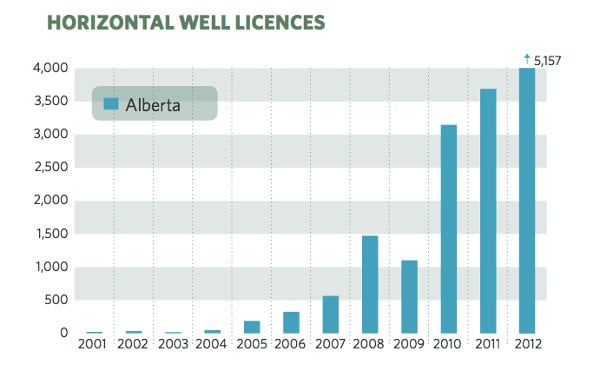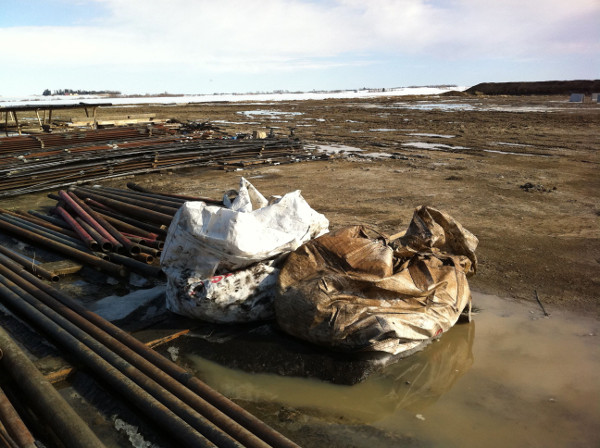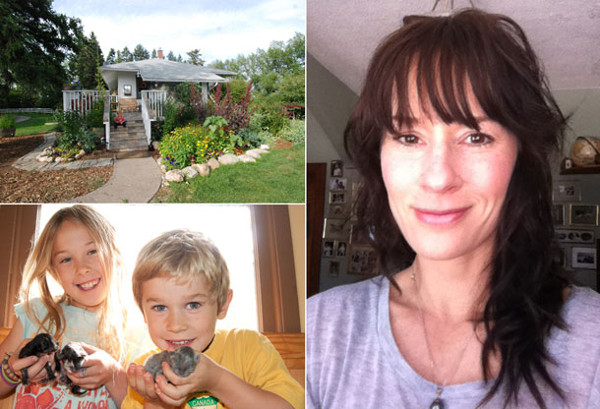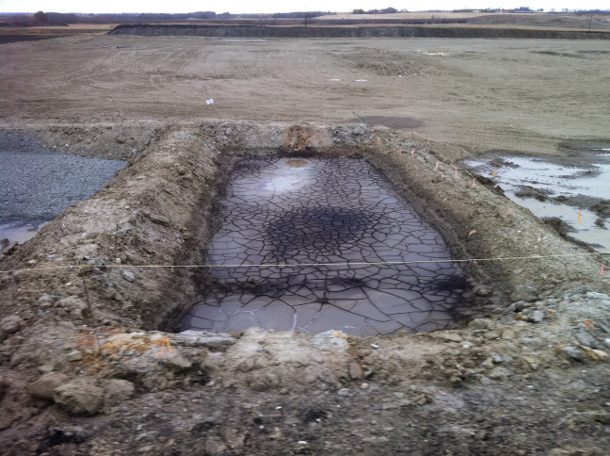When a tight oil boom invaded rural Alberta five years ago, Diana Daunheimer was, as she puts it, just another "ignorant landowner."
The mother of two and vegetable farmer knew little about the practice of horizontal drilling or multi-stage hydraulic fracturing.
The practice involves the injection of highly pressurized fluids into mile deep wells that later mole out horizontally for another mile or two, in order to break open shale rock as tight as granite.
To coax lower-quality oil out of the Cardium Formation as well as other pancakes of shale rock deep below west-central Alberta, industry increased its use of the practice around 2009 and created a black gold rush that has industrialized many rural communities with constant traffic and polluting flare stacks.
Daunheimer knew even less about the Alberta Energy Regulator, formerly the Energy Resources Conservation Board, which referees the industry in the province.
But as the number of horizontal fractured wells in the Cardium Formation jumped from 70 to 2,000 over four years, and oil production skyrocketed from 2,000 to 80,000 barrels a day, Daunheimer quickly became informed.
And with five fracked wells owned by Calgary-based Angle Energy, and another one by Bonavista, about half a kilometre from her home, she's formed some strong opinions on the mining process -- and become a royal pain in the butt for industry and regulators alike.
Daunheimer, who studied science in university, recently warned a Yukon legislative committee currently studying the benefits and risks of fracking in that territory to "courteously decline" the technology.*
"Wait and see the fallout from what's happening in the United States and what's going to happen south of you, folks, and then if you still feel it's an economically-wise decision, then look at it," she said on Feb. 13.
The 39-year-old is also suing Angle, now owned by Bellatrix, for $13 million. Filed three months ago, her claim alleges that the company did not exercise reasonable care while fracking its oil and gas wells near her home between 2008 and 2012.
It also alleges that Angle's drilling activity resulted in damaged property, dead livestock, a tumour on Daunheimer's daughter's neck and contaminated well water, along with two years of unrelenting stress.
A statement of defence filed by Angle in early February denies all of Daunheimer's claims.
Daunheimer is handling the lawsuit, which she calls "extremely frustrating and life-altering," on her own, because she says she likely knows more than most lawyers about the industry and couldn't afford to do it any other way.
"I call myself mommy bear," she says. "I protect my young, and I love where I live. I put my heart and soul into this house. I got married here. Why should I get pushed out of my home just because someone is doing stuff illegally? It's insane."
Industry routinely claims fracking is "safe and proven," and the Alberta Energy Regulator, likewise, assures landowners that the practice is "responsible" and that "cumulative impacts are minimized."
But that's not what Daunheimer says she experienced around her home, which her family purchased in 2002. "We've had all the cumulative impacts any family can handle," she says.
In Alberta, several landowner groups, municipalities, the city of Lethbridge, water experts, and politicians have also raised concerns about the practice.

Brian Mason, Alberta's New Democrat leader, recently charged that fracking is not only "out of control" but "is increasing on a dramatic scale without any understanding of what the potential consequences will be."
A sour new neighbour
For years Daunheimer, a former environmental coordinator for the city of Airdrie, raised organic vegetables for high-end Calgary restaurants on her acreage.
But in 2008 her life started to change, when Angle drilled and fracked two wells simultaneously 25 metres apart with highly-pressurized fluids some 400 metres from her farm, west of Didsbury in south-central Alberta.
It caused endless traffic, noise and diesel fumes, but the Daunheimers figured that was normal activity in a province dependent on hydrocarbon revenue.
The family sat up and took notice, Daunheimer says, when the company drilled and fracked a sour gas well south of the property in Aug. 2010.
After performing a propane fracture on the well, located 377 metres from their house, the company then burned off unwanted gas for 19 days.
The company flared off "all the non-profitable gas to get to the money-making oil," explains Daunheimer -- a common practice in the oil patch and now recognized as wasteful and a potential risk to public safety in North Dakota.
Two incinerators that sounded like jet engines roared day and night. The smoky pollution terrified her chickens and goats and gave the family headaches, spells of dizziness and chronic respiratory infections, she says.
People in the industry (Daunheimer's husband, Derek, is a rig manager in the oil patch) told the family that they should have been evacuated during the event.
Three weeks afterwards, the family's goats aborted 50 per cent of their offspring, while Daunheimer's 10-year-old daughter developed a tumour on her neck.
It took Daunheimer a while to take action. Only after using freedom of information laws to access drilling and other records last year did she realize the potential danger and scale of chemical exposures posed by the nearby wells.
As a consequence, the family will be seeing an Edmonton toxicologist next month. "The look you get from doctors when you try to explain your concerns regarding industry activity affecting your family's health is one of pure disregard and disbelief," says Daunheimer.
Sour gas, a cyanide-like poison toxic to humans and animals at low concentrations, sinks and collects in low areas, and the Daunheimer's house is located in a depression. The family says they could smell sour gas for years.

The company swore the fumes didn't originate from their operation.
Daunheimer later discovered that the well was licensed to vent waste gases, but that no one notified the family. An email from an Angle employee informed her of that fact. Regulatory records also revealed that compressor stations at two wells each released 15,000 cubic metres of waste gas every month.
Jacked up flaring
At that point Daunheimer began studying industry regulations, as well as the combustion efficiency and contents of flares.
She found studies by the Alberta Research Council that showed flares often burned with 62 per cent efficiency more than a decade ago, meaning landowners downwind often breathed as many as 150 highly toxic hydrocarbons.
Based on general emission reports filed with the regulator, as well as material safety and data sheets on fracking fluids, "We know now that we've been exposed to raw benzene," says Daunheimer.
More and more Albertans are being exposed to the same kind of materials that have contaminated airsheds wherever tight oil booms and fracking have exploded, such as Texas and North Dakota.
Due to a dramatic increase in fluid injection down horizontal wells driven by fiscal and royalty incentives, the amount of waste gas being vented or flared from oil wells has mushroomed in the province since 2006, as it did in North Dakota.
In its 2013 flaring report, the Alberta Energy Regulator directly attributes a 25.9 per cent increase from 2011 to 2012 in the disposal of flared waste gas into the air "to an increase in new crude oil production and low gas prices, which makes the economic viability of conservation more challenging."
The regulator blamed the increase in flared gas to "the number of horizontal multistage fracturing operations in 2012. It takes longer to recover load fluids and clean out wells in these operations, which results in greater flare volumes and flaring duration."
Daunheimer also encountered large sump pits, or dugouts designed to store drilling waste, at a newly fracked wellsite northeast of her property in July 2012. (Another wellsite south of her home sported stacks of pipes leaking oil.)
She suspected the sump pits were illegal because they could leach water contaminated with hydrocarbons into groundwater or the nearby Rosebud River.
Alberta Environment, one of two provincial agencies responsible for groundwater protection, expressed concern, but said it couldn't do anything, Daunheimer says.
Concerned about the safety of her own well water (chemical tests revealed problems), she then complained to the Alberta Energy Regulator.
One of its inspectors eventually checked out the unlined and unfenced pits. His report noted that the pits smelled "heavily of hydrocarbon-based drilling fluids." As a consequence, the regulator issued "a high-risk compliance order" against Angle to clean up the mess.
Daunheimer filed a freedom of information request to the government in order to get a copy of the enforcement order, which shut down the company for a day in 2012 while it removed the oily waste from one pit. It took the company another year to fully clean up the site.
Meanwhile, another branch of the Alberta government botched a drinking water well test that Daunheimer requested after a routine chemical sampling showed evidence of hydrocarbon contamination.
The government initially reported that its test "did not show anything of concern" last December, but after Daunheimer raised concerns about the quality of the testing, it later admitted in an email that "there were so many mistakes made by the lab in the first testing event" that they would have to resample the well.
There were also noise concerns. In Alberta, the oil and gas industry must keep its equipment at 50 decibels during the day and 40 decibels at night.
But a compressor station roared away in violation of regulations for two-and-a-half years, Daunheimer says, adding after she pointed out the violation to the regulator, the company quietly removed it.
By 2012, the company refused to talk to the family, while the regulator expressed frustration at Daunheimer's scores of emails and phone calls, she says.
Lost down the well
Although industry and government typically advertise fracking fluids as water-based and as harmless as guar gum in ice cream, Daunheimer found the opposite.
One well near her home, based on information she found on the industry website FracFocus, was primarily fracked with diesel fuel, light aromatic solvent naptha, and kerosene.
FracFocus, a voluntary registry set up by industry, lists the contents of hazardous fluids injected during fracking operations in North America, often three months after the fact. A Harvard legal study concluded in 2013 that the industry registry "prevents states from enforcing timely disclosure requirements, creates obstacles for compliance for reporting companies, and allows inconsistent trade secret assertions."
Other wells by Daunheimer's home were blasted with frac oil, synthetic frac oil or diesel invert (drilling fluid). Material Safety Data Sheets (MSDS) on frac oil warn that the product is "highly flammable" and "contains benzene, a proven human carcinogen."
Diesel fuel also contains benzene, toluene and xylene. All can contaminate groundwater and cause cancer, kidney damage, liver damage, or harm to the brain if ingested by humans.
After checking well reports, Daunheimer raised particular concerns about the loss of 362,000 litres of diesel invert down one well near her home.
Industry refers to the disappearance of drilling fluids down the wellbore as "lost circulation."
At first the regulator explained to Daunheimer that industry never lost drilling fluid and that the hazardous substances couldn't migrate anywhere, she says.
But industry data she later found indicated that every well in Western Canada loses between three and five cubic metres of drilling fluid per 100 metres drilled.
Daunheimer also raised questions about 20,050 litres of frac oil that disappeared down a well. After the regulator again told her not to worry, she checked industry data.
During fracking operations, industry only recovers about 20 per cent of the frack fluid sent down the well. Frack breakouts or hits that spill fluid and water into nearby wells have happened scores of times in British Columbia and Alberta.
The issue has been particularly intense for drilling and fracking tight oil formations along the Rockies in Alberta.
One servicing company recently explained that fracking in these fields without a good reading of reservoir behaviour often runs "the risk of intersecting and/or reactivating geological structures such as faults during hydraulic fracture stimulation."
In addition, "faults may serve as conduits for large volumes of fluid, acting as a thief zone and re-directing fluid and proppant [sand] away from the treatment zone and wasting valuable time and money. In naturally fractured formations, an additional risk of diverting frac fluid into faults is the risk of generating induced seismicity of large enough magnitude to be felt on the surface."
According to Daunheimer, the regulator later assured her that the loss of the drilling fluid couldn't be classed as a spill or toxic release. Its employees reasoned that "the chemical was lost most likely in a hydrocarbon bearing formation so that would not constitute a known loss to the environment," says Daunheimer.
A 2012 study by U.S. hydrologist Tom Myers estimated that man-made fractures combined with natural faults in heavily drilled fields might well speed up the rate of fluid migration from drilling or fracking such that "contaminants could reach the surface areas in tens of years, or less."
'I'd say it's got to stop'
Daunheimer also raised questions about methane leaks at the wellsites, or what industry calls surface casing vent flow. That's when methane bubbles out of the wellbore into groundwater, soil or the atmosphere.
It's an issue that particularly plagues wells that have been subjected to the wear and tear of hydraulic fracturing. According to Alberta studies, nearly one-third to 70 per cent of all deviated or horizontal wells leak.
The methane leaks are also expensive to fix. One 2010 Alberta industry paper ruefully noted: "The repair of these situations is a non-revenue generating exercise with the potential to reach significant expenditures."
An inspection by a summer student found one leak on an Angle well near Daunheimer's home in 2010. Daunheimer checked Alberta's regulations and found that the company hadn't reported or fixed the leak for three years. The energy regulator later confirmed her analysis, but did little else, she says.
"As I mentioned previously you are correct that Angle Energy did not report the surface casing vent flow at the 14-15-031-02W5 well to the AER in the proper manner," emailed Tyler Callicott, a manager of enforcement and surveillance in the Red Deer office of the Alberta Energy Regulator, earlier this year.
After Calgary-based Bellatrix bought out Angle for a half a billion dollars last year, it assumed all of Angle's liabilities.
The regulator did not reprimand Bellatrix because Callicott "did not find sufficient evidence that they were aware of the vent flow."
Explained Callicott: "I did find evidence that Angle Energy was aware of the vent flow and failed to report it, as Angle Energy is no longer the licensee of this well and no longer an active licensee I will not be issuing a non-compliance to them."
Daunheimer now regards the regulator's claim that they protect landowners and the environment as a joke. "I have come to see the [regulator] as nothing short of a bodyguard to the industry," she says. After Daunheimer filed her lawsuit against Angle last December, the regulator told her that it was done with her and was closing her file, she says.
On Feb. 10, Daunheimer alerted the board that three wellsites near her home had flared beyond their legal 72-hour period. She wondered "if the companies had properly requested extensions to flare further."

The next day she received a reply from Jen Lutz, director, community relations, Alberta Stakeholder Engagement Branch of the Alberta Energy Regulator.
It read: "On Dec. 19 we discussed Angle's facilities near your location. The files have been closed and we are not going to review further historical operational performance concerns. These files have been thoroughly reviewed and enforcement actions were issued."
Carrie Rosa, senior advisor for the Alberta Energy Regulator's public affairs, explained that "Any non-compliances that were identified at the time, were dealt with and the follow up was completed. Any new complaints regarding current operational issues continue to be accepted."
Furthermore, "The [regulator] was not able to verify or confirm Ms. Daunheimer's assertions regarding flaring contraventions and therefore could not take action."
But Daunheimer hasn't closed her file on the impacts of horizontal hydraulic fracturing.
"I'd say it's got to stop," says Daunheimer. "The volumes of benzene and other highly toxic substances that have been used, burnt, spilled and injected into the land, air and water about us is staggering and frightening."
Meanwhile, Daunheimer is preparing to take her case to court. "I'm taking this to the next highest level possible."
Angle denies all of Daunheimer's claims. In its statement of defence filed in early February, the company writes: "None of these instances of non-compliance resulted in the escape of toxic chemicals, drilling waste, flare gases, or other noxious substances onto the Daunheimer Property."
The company "denies that its oil and gas operations contributed to or caused the injuries and damages alleged in [Daunheimer's] Statement of Claim."
It adds that "allegations in the Statement of Claim that are critical of the [Alberta Energy Regulator], its investigator, its directives, and [allegations] that the AER is funded and controlled by the oil and gas industry... are false."
The regulator is funded 100 per cent by the oil and gas industry and is directed by Gerard Protti, a former lobbyist and founder of the Canadian Association of Petroleum Producers.
Last December Bellatrix offered Daunheimer $50,000 to drill a new water well and plant some trees if she would withdraw her lawsuit. But the determined mother declined the offer.
"Are you kidding?" she says. "I'm so not done yet."
*Correction, Feb. 28 at 12:30 p.m.: A previous version of this story incorrectly stated that Diana Daunheimer has a university science degree. ![]()
Read more: Energy, Environment
















Tyee Commenting Guidelines
Comments that violate guidelines risk being deleted, and violations may result in a temporary or permanent user ban. Maintain the spirit of good conversation to stay in the discussion.
*Please note The Tyee is not a forum for spreading misinformation about COVID-19, denying its existence or minimizing its risk to public health.
Do:
Do not: